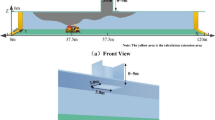Abstract
Seepage of flue gases into the environment through the chimney of thermal power plant smoke stacks often occurs during their operation, causing intensive damage to them. This phenomenon occurs due to the difference of pressure between the smoke stack inner and outer surfaces when the stack is streamlined by the flow of atmospheric air. The smoke stack operating conditions as a function of the stack load and wind conditions was studied. In particular, the excess pressure in the smoke stack shaft is estimated according to L.A. Rikhter’s criterion, and the static pressure along the stack height is calculated. The motion of combustion products in the smoke stack shaft and streamlining of the shaft by cross flow of atmospheric air are simulated in separate and combined statements using 3D models at different values of flue gas flowrate and wind velocity. It is shown from the study results that assessment of excess pressure conditions in a smoke stack according to Rikhter’s criterion is not sufficiently correct, because it does not take into account the windinduced underpressure outside of the smoke stack. Numerical investigations carried out using 3D models showed that quite extensive zones with underpressure exist at the smoke stack outer surface when the stack is streamlined by atmospheric airflow. The greatest underpressure is observed under such conditions on the smoke stack lateral surfaces with respect to the wind direction. At a certain wind velocity, the underpressure outside of the stack becomes greater than it is inside of the stack, as a result of which zones appear on the stack surface in which flue gases seep through the shaft into the environment. An analysis of the obtained data showed that the seepage intensity increases with the wind velocity. On the other hand, the area of these zones and the difference of static pressures in them decreases with decreasing the flue gas flowrate.
Similar content being viewed by others
References
A. M. El’shin, M. N. Izhorin, V. S. Zholudov, and E. G. Ovcharenko, Smokestacks, Ed. by S. V. Sat’yanov (Stroiizdat, Moscow, 2001) [in Russian].
A. P. Maneev, M. I. Nizovtsev, and V. I. Terekhov, “Influence of wind on seepage of gases through the shell of smoke stacks,” Therm. Eng. 60, 248–254 (2013). doi 10.1134/S004060151304006X
A. P. Maneev and V. I. Terekhov, “Specific features of heat transfer on the external surface of smoke stacks blown by wind,” Therm. Eng. 62, 183–189 (2015). doi 10.1134/S0040601515030064
L. A. Rikhter, D. P. Elizarov, and V. M. Lavygin, Auxiliary Equipment of Thermal Power Plants: Textbook (Energoatomizdat, Moscow, 1987) [in Russian].
E. V. Subbotin, V. A. Luzhkov, and V. A. Pazushchan, “Taking into account the gradient of static pressures inside and outside the chimneys during evaluation of causes of their destruction,” Bezop. Tr. Prom-sti., No. 6, 31–32 (2006).
ANSYS Help 14.5 Release.
Author information
Authors and Affiliations
Corresponding author
Additional information
Original Russian Text © P.V. Roslyakov, I.L. Ionkin, I.V. Morozov, 2018, published in Teploenergetika.
Rights and permissions
About this article
Cite this article
Roslyakov, P.V., Ionkin, I.L. & Morozov, I.V. Specifics of Smoke Stack Operation under Wind Effect Conditions. Therm. Eng. 65, 232–238 (2018). https://doi.org/10.1134/S0040601518040080
Received:
Accepted:
Published:
Issue Date:
DOI: https://doi.org/10.1134/S0040601518040080




